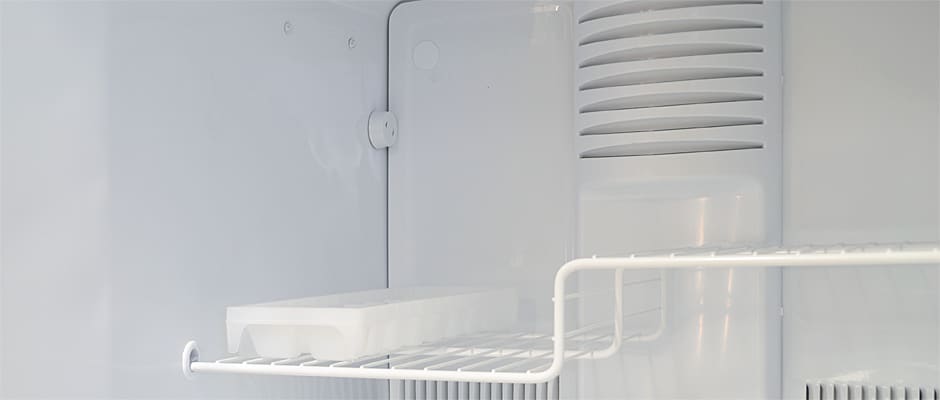Introduction
Design & Usability
Making changes that no one asked for.
A stainless steel exterior finish with a prominent grain and doors with reversible handles create a fridge that looks... well, like almost every other generic, fairly cheap, stainless top freezer on the market. There's almost nothing innovative here with respect to design, and what is different doesn't seem to add much in terms of functionality. Having one full-width shelf and two half-width ones in the fridge makes for easier cleaning, but limits storage customization. The two-level freezer shelf... has two levels. It's a design choice that may make storing large or tall items easier, but it just felt arbitrary to us. And don't get us started about the door shelves; with all the gaps, nooks, and crevices, you can kiss spill containment goodbye.
The more interactive parts of the fridge aren't really any better. The weird dial-based thermostat is vague and feels very cheap, but it allows you to control the two compartments independently. A bright orange sticker was attached—in a very askew manner, we might add—indicating which arbitrary dial number was the correct one to use. Unfortunately, the fridge ended up needing some additional calibration, and the act of using those odd control dials was exceedingly frustrating: they were difficult to turn, didn't click solidly into place, and correlated with inaccurate temperatures to produce a crap-shoot thermostat that causes more irritation than satisfaction.
{{photo_gallery "Front", "Fingerprints", "Handle", "Interior", "Fridge", "Controls", "Crisper Drawer", "Fridge Door", "Freezer", "Freezer Door", "Side", "Back"}}
Performance & Features
Too much money for too much mediocrity.
If the MSRP on this fridge were three or four hundred dollars less than what it is, we could have argued that you'd be getting what you paid for. As it stands, a $999 fridge should be fairly accurate, even if it's not very pretty. The GTH18ISDSS proved to be only moderately accurate, the product of a shoddy thermostat and poor air circulation. Normally, we see temperatures in a refrigerator compartment gradually warm up as the air falls. Oddly enough, the top of the GE started out a little warmer than we'd like, cooled off to our preferred temperature in the middle, and then got even warmer at the bottom. While it's not a level of performance that will remove this fridge from any consumer consideration, the freezer downright failed to ever hit the ideal zero degrees despite being calibrated to a cooler thermostat setting. That's just sloppy.
Moisture retention in the vegetable drawer was more or less average, a surprising and welcome result given that the drawers in this GE have no humidity control. Storage space all around was fine, no surprise given the very traditional layout of the interior shelves. The one truly redeeming factor here is the energy efficiency levels we saw in this fridge. We can't say why—perhaps due to the lack of ice maker or water filter, or possibly as a result of an underperforming thermostat—but this GE is exceptionally energy efficient. Assuming you keep food waste to a minimum, you'll very likely see some long-term savings on your electric bill.
Conclusion
The acronym here should stand for "Generally Evaded".
No product truly exists in a vacuum. Each item that we test is judged on its own merit, but is also placed into a general context involving fridges of similar style, size, and price. For instance, the GE GTH18ISDSS could have been a fridge worth recommending despite its performance issues if only the price had been lower. Sporting a mid-range MSRP of $999 combined with budget-range performance, however, it simply can't hold up to other fridges in its bracket. Sadly, you won't be able to find it on sale very easily... or at all, for that matter. This fridge has been taken off the GE website, which means it's discontinued. You can find nearly identical models for the same price, however, but if they perform as poorly as this one did, your best bet would be to avoid those ones, as well.
Introduction
The bane of the GE GTH18ISDSS was undoubtedly its poor temperature calibration. With average ratings everywhere else—in conjunction with some pretty fantastic energy ratings—this product has so much potential. If a refrigerator doesn't live up to the verb embedded in its title, however, then what's the point?
Temperature Performance
$699 worth of performance in a $999 fridge.
Temperature consistency throughout the various zones of this product's internal compartments was the biggest concern that we had after examining our test results. Over time, both the fridge and freezer exhibited an average fluctuation of 0.3 degrees, a very consistent and positive result. However, the temperatures themselves weren't quite as spot on. The fridge, for instance, averaged 38.96 degrees Fahrenheit at the top, 37.4 degrees in the middle, and 40.09 degrees near the crispers. A gradual shift is understandable—in fact, slightly warmer temperatures are preferred for fresh produce—but this spotty, jumpy temperature output is more indicative of poor air flow.
The freezer is even worse. It's not a terribly tall compartment, and yet we still saw a difference of almost two degrees. The top clocked in at 5.4, while the average degree near the bottom was roughly 7 degrees even. Keep in mind that we had actually gone a step further and cranked up the freezer thermostat, and it still never reached the ideal zero degree mark. The fridge section managed to stay within a range that would be acceptable on a cheaper fridge, but the freezer is flat out disappointing; we would except this sort of data on a substantially cheaper model.
{{photo_gallery "Fridge Temperature", "Fridge Temp Graph", "Freezer Temperature"}}
Moisture Retention
Decent: the highest preservation compliment we could give.
Thankfully, there was one aspect of this fridge's performance with respect to actual food preservation that managed to garner some praise. The crisper drawers lacked any sort of humidity adjuster, so our hopes weren't high. Nevertheless, this one trick drawer managed to lose just 0.18 gram of moisture per hour. It's solidly average, not a bad thing for a fridge in this price point.
Freezing & Thawing
Two tests that prove this fridge isn't completely awful.
Freezing and thawing tests are sort of the pass/fail component of our testing procedures. Very few fridges make an impact here one way or the other. With freezing times of one hour and 45 minutes, this GE will preserve room temperature food without a huge loss of texture or quality. That length of time is acceptable, though it is getting close to the edge of the spectrum that we'd be happy with. As far as retaining that cold air, this fridge's insulation prevented temperatures from reaching even 23 degrees Fahrenheit after going 36 hours without power.
{{photo_gallery "Freezing Graph", "Power Loss Graph"}}
Storage Space & Energy Efficiency
The best thing about this fridge? Low electric bills.
This fridge offered up very few surprises in terms of its overall layout, and as such, it had a very average amount of usable storage space. Taking into account the sections blocked by controls, lights, and other obstructions, the assorted shelves and drawers inside the fridge proper totaled a decent 9.35 cubic feet of usable space. The freezer, despite its odd two-tier shelf, also came out with a very average number: 4 cubic feet even were spread out over the two main shelves and the two found on the door.
As it so happens, the area where this fridge really shines is one which many consumers value but may not actually notice: energy efficiency. At a rate of $0.09 per kWh, we determined that it would take a measly $22.05 to operate this GE for a full year. Spread that out over the usable storage, and you've got a fridge that requires a mere 0.05 kWh per cubic foot to operate. That's exceptionally affordable and efficient, making it one of the most budget-friendly fridges we've ever seen. If you can still find one on sale, a hefty store discount combined with the long-term energy savings could make a money-conscious consumer very happy.
{{photo_gallery "Fridge Storage", "Fridge Door Storage", "Freezer Storage", "Freezer Door Storage"}}
Meet the tester
Matthew is a native of Brockton, MA and a graduate of Northeastern, where he earned a degree in English and Theatre. He has also studied at the Gaiety School of Acting in Dublin and spends most of his free time pursuing a performance career in the greater Boston area.
Checking our work.
Our team is here for one purpose: to help you buy the best stuff and love what you own. Our writers, editors, and lab technicians obsess over the products we cover to make sure you're confident and satisfied. Have a different opinion about something we recommend? Email us and we'll compare notes.
Shoot us an email


